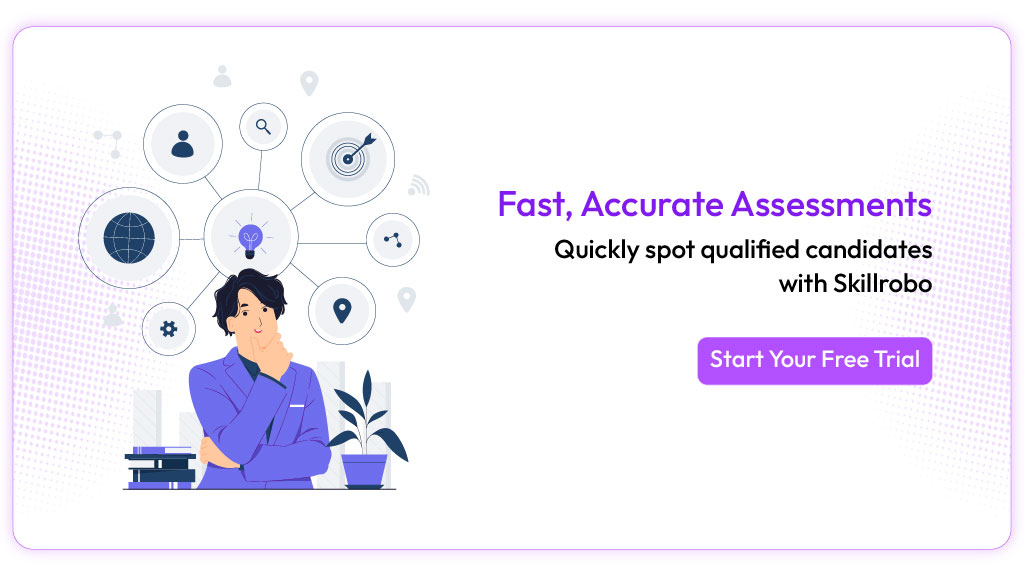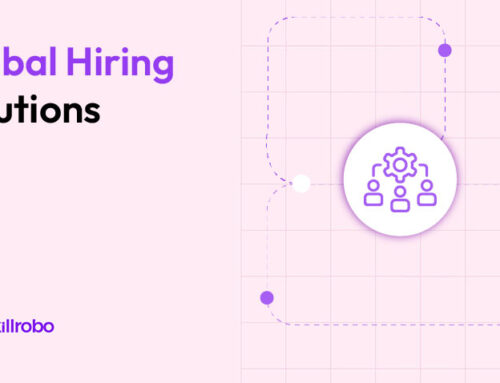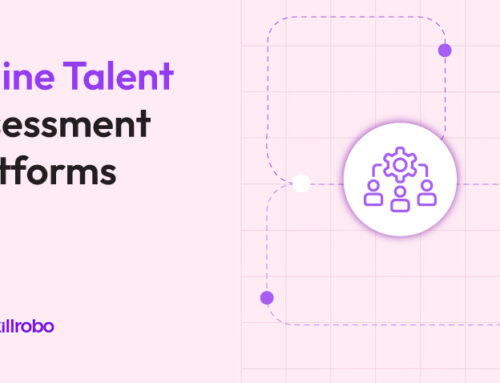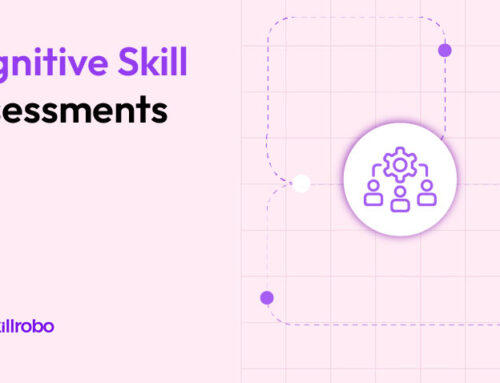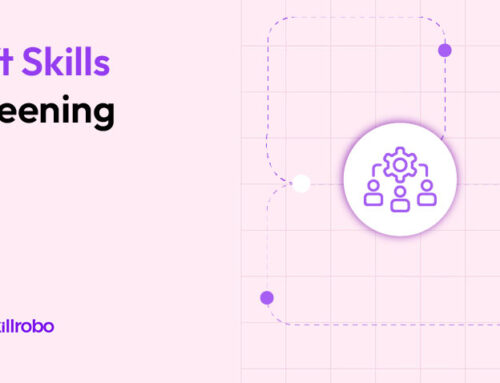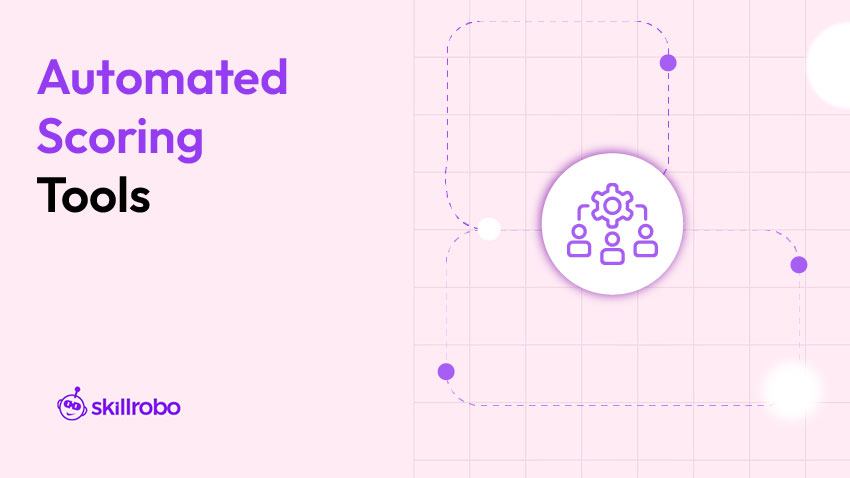
Key Takeaways
- Automated scoring tools eliminate manual review, speeding up shortlisting while maintaining objectivity in candidate evaluations.
- Tools with real-time analytics help HR teams benchmark aptitude and identify top performers faster.
- Platforms offering customizable scoring for open-ended and logic-based questions improve test accuracy and fairness.
- Skillrobo supports automated scoring across question types, enabling scale and consistency in modern hiring.
Why Manual Scoring No Longer Works at Scale
As hiring volumes grow and job roles diversify, the traditional approach of manually scoring aptitude tests, especially open-ended and logic-based responses, falls short on multiple fronts. It’s time-consuming, introduces human bias, and often delays hiring decisions at a time when speed and consistency are critical. Consider a recruiter screening 300 applicants for five roles across departments. Reviewing subjective answers manually could take days, slowing down pipeline movement and frustrating top candidates.
Automated scoring platforms solve this by:
- Eliminating inconsistencies between different evaluators
- Accelerating feedback cycles, enabling faster shortlisting
- Standardizing evaluation criteria, supporting fair and equal assessments across candidates
These platforms evaluate MCQs, logic puzzles, case simulations, and even text-based responses using pre-programmed logic or AI interpretation—freeing HR teams to focus on strategy, not spreadsheets. Want to know how scoring feeds into broader hiring intelligence? Explore how candidate assessment tools provide a central dashboard to track performance trends across assessments and hiring cycles.
What Makes a Scoring Engine ‘Smart’?
Not all automated scoring tools deliver the same value. A “smart” scoring engine adapts to diverse test formats, understands question intent, and generates clear, actionable insights for hiring teams. Here’s what truly sets the best engines apart:
1. Instant evaluation of MCQs and logic-based questions
MCQs are scored in real-time, with analytics breaking down which questions were most frequently missed. This provides visibility into knowledge gaps and test quality.
2. Rule-based scoring for open-ended or descriptive responses
Rather than subjective grading, rule-based logic checks for the inclusion of key concepts, structured arguments, or predefined criteria—ideal for writing tests or problem-solving caselets.
3. Real-time dashboards that visualize performance by category
Smart engines don’t just return a score—they categorize it. Recruiters can instantly see how candidates performed in logic, communication, or decision-making, based on predefined tags or benchmarks. Curious how this helps in soft skills evaluation, too? See how communication skills assessment tools integrate into scoring dashboards for roles demanding clarity and persuasion.
4. Custom rubrics to reflect job-specific expectations
Hiring for a strategist vs. a sales rep? Scoring systems can weigh creativity or numeric reasoning differently based on role needs. Recruiters can adjust rubrics for fairness and relevance.
5. AI-assisted checks for soft skills or behavioral traits
Advanced platforms use Natural Language Processing (NLP) to interpret written responses, evaluating grammar, structure, sentiment, and even alignment with company values. It’s a smarter, faster way to assess behavioral indicators without relying solely on interviews. Explore how psychometric assessment tests also factor into scoring engines, helping recruiters detect personality traits and cultural fit early in the process.
Some even use NLP (natural language processing) to evaluate written responses based on relevance, grammar, and clarity, far beyond basic keyword matching.
Use Cases That Benefit Most From Automated Scoring
Automated scoring brings measurable efficiency, accuracy, and scalability to hiring workflows—but it’s especially transformative in specific use cases. Let’s explore where it truly shines.
1. High-Volume Roles: Customer Service, Tech Support, Operations
When hiring at scale, manual review creates bottlenecks. For customer-facing or support roles, where recruiters often assess hundreds of candidates in a day, automated scoring eliminates the need for repetitive evaluations. These roles require fast, consistent assessment of communication skills, logical reasoning, and attention to detail. Platforms with auto-grading capabilities for MCQs, scenario responses, and short text entries can quickly highlight qualified candidates while maintaining consistency. Using candidate assessment tools with scoring automation also ensures that the evaluation process stays fair and efficient, especially important when test volumes spike during seasonal or mass recruitment drives.
2. Technical and Cognitive-Heavy Roles
For roles like developers, analysts, or finance specialists, test complexity often increases, and so does the margin for subjectivity if evaluated manually. Automated scoring handles coding logic, numerical aptitude, and reasoning tests with speed and precision. For example, when assessing analytical skills in a finance candidate, logic-based questions and numerical caselets can be auto-graded using benchmarked formulas. Combining automated scoring with pre-employment accounting assessments allows companies to test quantitative reasoning, data accuracy, and financial decision-making—all without manual calculation or review delays. This integration supports role alignment and ensures only high-fit candidates move forward.
3. Distributed and Remote Hiring Models
With hybrid and remote work now the norm, assessments are often taken asynchronously, across time zones and locations. Automated scoring ensures that candidates are evaluated with the same criteria and timelines, no matter where they are. This creates a uniform standard across global hiring and avoids issues like scheduling evaluator availability or regional inconsistencies in manual reviews. It’s especially important when hiring for technical or product roles where time-sensitive responses and standardized logic are critical.
4. Multi-Stage Hiring Pipelines
Modern hiring is no longer a single-interview process. Recruiters run assessments at multiple stages—from initial skill screening to deeper evaluations on decision-making, communication, and culture fit. In this structure, automated scoring acts as a foundational layer, keeping evaluations consistent across stages and helping recruiters track candidate progression with data. This allows hiring managers to compare assessment results over time, uncover skill development trends, and even validate performance post-hire. Whether it’s used in round one or final interviews, automated scoring improves the efficiency and defensibility of the entire pipeline.
Pro Tip: Use automated scoring as a pre-screening layer, then route top candidates to skill-specific interviews.
Comparison Table: Top Tools with Automated Scoring Features
| Tool | Best For | Scoring Features | Real-Time Reports |
|---|---|---|---|
| Skillrobo | Custom role-specific testing | Auto-scoring + SEYARC AI for open-ended questions | ✓ |
| Testlify | Coding and cognitive testing | AI-based evaluation of custom questions, real-time results | ✓ |
| NinjaInterview | High-volume and startup hiring | Logic scoring + weighted rubrics for MCQs and scenarios | ✓ |
| Tao Testing | Educational and compliance testing | Open-source rule-based scoring engine with LMS integration | ✓ |
| SurveySparrow | Lightweight test delivery | Simple scoring for quizzes and survey-based assessments | ✓ |
Why Automated Doesn’t Mean Impersonal
A common fear in recruitment is that automated scoring might dehumanize the hiring process, reducing candidates to numbers and bypassing personal judgment. But the truth is quite the opposite.
Automation removes the bias and inconsistency that often creep in during manual evaluations, particularly when multiple hiring managers or recruiters are involved. By creating a standardized baseline, automation allows humans to focus their attention on what truly matters: evaluating team alignment, cultural fit, and long-term potential.
For example, pairing automated scoring with psychometric assessment tests or personality-fit tools gives recruiters a full-circle view of a candidate. You’re not just measuring what someone knows—you’re learning how they think, interact, and grow under pressure.
Platforms that offer integrated insights from both cognitive and soft skill assessments empower hiring teams to make more informed and holistic decisions, while also delivering feedback faster—something today’s candidates highly value.
Pro Tips for Maximizing Automated Scoring Tools
To get the most value from your investment in automated scoring, it’s essential to implement it strategically. Below are tips to ensure the tools don’t just speed up hiring, but enhance hiring quality too.
1. Set Clear Rubrics for Open-Ended Responses
AI-driven scoring engines are only as good as the instructions and rules you define. Avoid vague criteria like “good writing” or “strong argument.” Instead, outline clear scoring parameters: does the response address all points, follow a logical flow, and use relevant examples?
This helps AI evaluate relevance and structure, not just word count or superficial complexity, ensuring more accurate results in writing or situational tasks.
2. Benchmark Top Performer Data
Use historical test results from your best employees to build internal benchmarks. For instance, if your top-performing sales reps consistently score above 85% on negotiation scenarios, that data can shape your shortlisting threshold. Comparing candidate cohorts over time helps identify trends, recalibrate test difficulty, and align assessments with evolving role expectations.
3. Avoid One-Size-Fits-All Scoring
Different roles call for different competencies. Don’t score a product manager the same way as a support associate. Customize weightage and scoring rubrics based on departmental needs, job seniority, and role complexity. This tailored approach ensures that every test reflects the real demands of the position, improving relevance and accuracy.
4. Leverage Analytics to Improve Test Design
Automated scoring platforms often provide performance breakdowns by category, question, or skill type. Use this data to flag questions that yield inconsistent scores, high dropout rates, or unexpected failure spikes. You can then refine or replace underperforming questions, improving the quality and fairness of your assessment pipeline.
Skillrobo – Built for Smarter Scoring and Hiring
If you’re looking to bring speed, objectivity, and insight to your hiring process, Skillrobo offers a comprehensive solution that automates what matters—scoring, feedback, and role alignment.
Skillrobo’s platform is built to handle both structured and unstructured assessments, making it ideal for companies hiring across departments and seniority levels. From logic-based MCQs to descriptive responses, Skillrobo ensures every candidate is scored consistently using predefined rules or AI-generated logic, powered by SEYARC AI. Here’s how Skillrobo enhances scoring accuracy:
- Custom Rubrics for Open-Ended Responses: Easily set evaluation criteria that reflect job expectations.
- Instant, Categorized Reports: See candidate scores by domain—communication, reasoning, technical knowledge, etc.
- Secure and Scalable Testing: With browser monitoring, webcam proctoring, and public test links, you can test anywhere, anytime, without compromise.
Automated Scoring Is the Future of Fair, Fast, and Smarter Hiring
Skillrobo empowers recruiters with fully customizable assessments and automated scoring logic for all test types—MCQs, fill-in-the-blank, and descriptive questions. SEYARC AI enhances scoring for custom formats, helping recruiters evaluate creativity and logic without manual review.
With instant reports, proctoring, and public test links, Skillrobo is built for speed, scale, and fairness. Sign up to create your first test and automate your next shortlist.
Table of content
- Key Takeaways
- Why Manual Scoring No Longer Works at Scale
- What Makes a Scoring Engine ‘Smart’?
- Use Cases That Benefit Most From Automated Scoring
- Comparison Table: Top Tools with Automated Scoring Features
- Why Automated Doesn’t Mean Impersonal
- Pro Tips for Maximizing Automated Scoring Tools
- Skillrobo – Built for Smarter Scoring and Hiring
- Automated Scoring Is the Future of Fair, Fast, and Smarter Hiring

